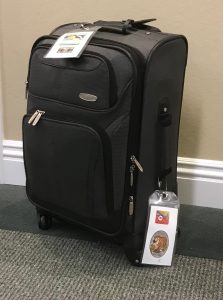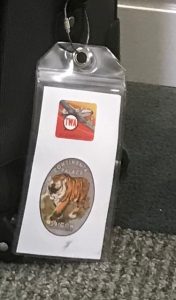One of the many stressful, error-prone inconveniences of modern air travel is identifying and correctly retrieving your checked luggage from among often hundreds of other remarkably similar looking bags. Worst case, in a distracted hurry, you incorrectly take someone else’s luggage and never recover your own luggage! 🙁
The cause of this problem is that most luggage today looks quite similar. Most bags are a dark gray or black color with rollers on one end and an extensible handle on the other end. The printed tags provided by the airlines are remarkably similar, featuring unreadable bar codes and numbers.
Most tags with your name and address that you can buy at convenience stores or other locations are small and frequently gray or black as well, looking at a distance like every other tag on every other bag.
Consequently, it is frequently impossible to identify your luggage until it is right on top of you, about to go by on the carousel. You may have to run after it or wait until it comes around again even if you can identify it. This is often stressful and frustrating after a long trip, especially on top of other mishaps or delays.
While I have never ended up with someone else’s bags, it is easy to see how a distracted traveler could fail to check the tag and leave the airport with someone else’s luggage, worst case never recovering their own luggage.
Here is my solution:

Historically, travelers solved this problem by putting labels or stickers, often provided by hotels or other travel related firms, on their luggage which was typically a hard surface. Modern luggage like mine is often canvas or some other soft flexible material. Stickers such as those now widely used to personalize laptops won’t stick properly to soft luggage.
However, one can use large cruise tags used for personalizing and tracking luggage on cruise ships (cruise tags are available through Amazon and other sources) to hold appropriately sized pieces of paper or cardboard with colorful distinctive stickers affixed to the paper or cardboard:

Here I used stickers derived from vintage luggage labels from the 1930’s and 1940’s. Books of stickers are available from Amazon and many other sources.
A cruise tag is a transparent flat pouch that can hold an identifying tag of your choosing or design. It is easy to cut a piece of paper or cardboard that fits within the pouch and mount stickers on the piece of paper or cardboard as shown.
Obviously, if you choose to follow my example, you should select your own stickers that reflect your personal identity and style, just as you would for a laptop.
Select a pattern of bright colors that is easily identifiable at a few dozen feet (roughly ten meters) — the typical size of a baggage carousel at an airport. As the bag approaches it will be easy to confirm your identification as the sticker becomes fully readable and retrieve your bag easily before it rushes past you.
Finally, yes I successfully used this DIY (do-it-yourself) solution to the checked bag retrieval problem on my latest trip across the United States. 🙂
(C) 2017 John F. McGowan, Ph.D.
John F. McGowan, Ph.D. solves problems using mathematics and mathematical software, including developing gesture recognition for touch devices, video compression and speech recognition technologies. He has extensive experience developing software in C, C++, MATLAB, Python, Visual Basic and many other programming languages. He has been a Visiting Scholar at HP Labs developing computer vision algorithms and software for mobile devices. He has worked as a contractor at NASA Ames Research Center involved in the research and development of image and video processing algorithms and technology. He has published articles on the origin and evolution of life, the exploration of Mars (anticipating the discovery of methane on Mars), and cheap access to space. He has a Ph.D. in physics from the University of Illinois at Urbana-Champaign and a B.S. in physics from the California Institute of Technology (Caltech).

